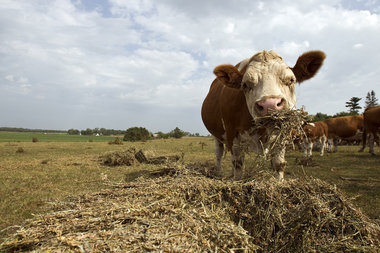Managing the winter feed gap can often be a challenge for producers. This gap is often characterised by a lack of available feed, which limits the daily intake of energy for stock. Quite simply, cattle can’t physically eat enough to meet their daily energy requirements.
Calving doubles a cows energy demands
The pressure this lack of available feed places on cattle is often exacerbated by other factors that include cold, wet or even snowy conditions which require additional energy to stay warm. And in many herds the end of winter is often a time where many spring calving herds see the first calves born. The energy requirement for a cow who has just calved effectively doubles with the calves arrival!
“focussing on the most appropriate supplement and correct feeding strategies to avoid waste and potential health risks.”
This period is really characterised by an energy deficit, bought about by the lack of available feed and the increased demand. So, for producers looking to manage this period, their focus needs to be on addressing the deficit. In turn this requires focussing on the most appropriate supplement and correct feeding strategies to avoid waste and potential health risks.
Providing energy to cattle often means considering the use of cereal grains; hays or silages or processed products such as pellets. Often rations will comprise a mix of grains and hays. It’s important to introduce grain into a ration over a period of days. The rumen needs time to adjust to the introduction of starch, so rushing a ration is something to avoid.
Even though you may plan on using a grain, or pellets, remember the rumen still requires some fibre to function effectively. So rations need to include around 20% roughage to avoid upset.
The other key risk is associated with how you may feed a ration. Grains and mixes can be fed daily in troughs or through feeders. This requires making some calculations to ensure that the feeder holds enough for the daily feeding levels. Don’t skimp on the never of feeders either. Cattle that can’t access feeders - by being shy or because they are smaller and easily bullied by more dominant animals can run the risk of either not eating and so falling short of their energy target. Or they may wait until the feeder is free and then gorge on the ration which can cause digestive upsets.
“It’s been demonstrated that feeding hay or silage onto the ground can result in wastage elevates of around 30% and that when it gets wet this can increase to 45%.
”
Feeding directly on the ground can also present risks for cattle. While pellets and hay can be fed out and consumed by cattle, there is a strong risk that cattle can inadvertently consume faeces, contaminated dirt or other materials that can cause either health problems or damage internal organs. An additional issue is that of waste. It’s been demonstrated that feeding hay or silage onto the ground can result in wastage elevates of around 30% and that when it gets wet this can increase to 45%.
Feeding on the ground poses risks from contamination such as manure
One cost effective strategy to feed pellets or mixed rations can be to construct troughs out of conveyor belting. This method allows troughs to be made to suit the mob size and can be easily disassembled or moved around. I have seen effective systems that use pipes bent into a shape to allow troughs to be built and moved. I’ve also seen other systems that use star pickets and wire to keep the belt in place.
Either method reduces the risk of consuming contaminated materials as well as reducing waste.
The important consideration is that the feed that is being provided is suited for the daily requirements of your stock without increasing risks.
If you are unsure how to plan a winter feeding program, don’t hesitate to contact me to discuss the best method for your business.






















































